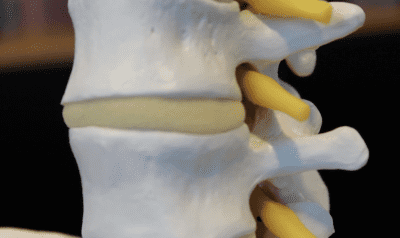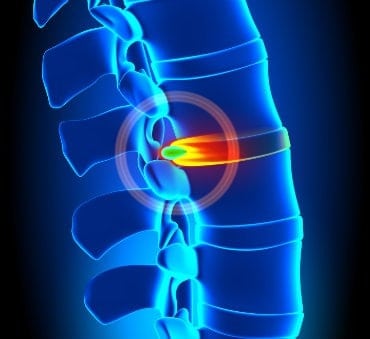What’s the Difference Between a Herniated and Bulging Disc?
- What Are Discs in the Spine For?
- Who’s at Risk for a Herniated or Bulging Disc?
- How Are Herniated and Bulging Discs Different?
- What Are the Treatments for Bulging or Herniated Discs?
- What Are the Advantages of Using Minimally Invasive Surgery to Treat a Bulging or Herniated Disc?
- What Can You Expect After Minimally Invasive Herniated or Bulging Disc Surgery?
A Herniated disc (also called a ruptured or slipped disc) results when a crack in the tough outer layer of cartilage allows some of the softer inner cartilage to protrude out of the disc. A bulging disc doesn’t always affect the entire perimeter of a disc, but at least a quarter if not half of the disc’s circumference is usually affected. Only the outer layer of tough cartilage is involved.
Many people interchangeably use “herniated discs” and “bulging discs,” and while both conditions affect the intervertebral discs, there are distinct differences between the two.
Ravi R. Patel, M.D., an orthopaedic spine surgeon who specializes in minimally invasive surgery of the spine; cervical, thoracic and lumbar spine surgery; and adult spinal reconstructive surgery at Orlando Orthopaedic Center, says many patients inquire about the differences between a herniated disc versus a bulging disc.
What Are Discs in the Spine For?
The discs act as cushions between the vertebrae of the spine and provide structural support and flexibility. The discs are composed of a thick outer layer that surrounds a softer gel-like center.
Over time, these discs will show signs of wear and tear. The discs begin to dehydrate, stiffen, and become less able to absorb everyday forces. As a result, the discs can no longer maintain their shape and may start to bulge or even herniate.
Who’s at Risk for a Herniated or Bulging Disc?

herniated and bulging disc
Beyond the natural wear and tear of discs, certain factors can contribute to one’s risk for developing a herniated or bulging disc. Some of these risk factors include:
- Gender. Men between 30 and 50-years-old are the most likely group to suffer from a herniated disc.
- Improper Lifting Technique. Lifting heavy objects with the back instead of the legs or twisting while lifting can both increase the risk for a herniated disc.
- Weight. Carrying excess body weight increases the stress on discs.
- Repetitive, Spine-straining Activities. Certain occupations, including those that involve a lot of pulling, bending or twisting, can place a substantial strain on the spine.
- Smoking. Nicotine can hasten degeneration and inhibit healing. Degenerated discs are less pliable and, therefore, more likely to tear or crack.
How Are Herniated and Bulging Discs Different?
With bulging discs, the affected area is at least 25-50% of the disc’s circumference, but not the entire portion (just the outer layer of tough cartilage is affected). Meanwhile, a herniated disc occurs when a crack in the tough outer layer of cartilage (called the annulus) allows some of the inner gel-like cartilage to protrude out of the discs.
A herniated disc is more likely to cause pain than a bulging disc because it generally protrudes farther and is more likely to irritate nerve roots. The irritation and discomfort come from compression or inflammation of the nerve.
“Bulging discs can occasionally cause symptoms such as leg pain, sciatica, or back pain,” explains Dr. Patel. “Herniated discs are more likely to be symptomatic simply because there is more disc material that’s pushed out.”
What Are the Treatments for Bulging or Herniated Discs?
For many patients, the disc injury will improve with conservative treatment methods, including:
- Oral steroids to decrease nerve inflammation and provide pain relief
- Oral medications for severe pain
- A combination of physical therapy and exercise to alleviate pressure on the nerve root
- Epidural injections to reduce pain and inflammation
- Manual traction to stretch the discs and create more room for the nerves
What Are the Advantages of Using Minimally Invasive Surgery to Treat a Bulging or Herniated Disc?
 Some of the common minimally invasive same-day surgical procedures include:
Some of the common minimally invasive same-day surgical procedures include:
- Anterior cervical discectomy and fusion (ACDF) – This procedure involves removing a disc from the cervical spine (neck) and then stabilizing the segment with a bone graft or implant.
- Cervical Disc Replacement – This procedure removes a patient’s cervical (neck) herniated disc and replaces it with an artificial disc.
- Cervical Laminoforaminotomy – This procedure, also called a posterior discectomy, is used to remove arthritic bone spurs and herniated discs from a posterior approach (back of the spine).
- Lumbar Microdiscectomy – This procedure removes a lumbar (low back) herniated disc through minimally invasive outpatient techniques
Unfortunately, conservative treatment options are not always effective for all patients with symptomatic herniated or bulging discs. Before considering surgery, an orthopaedic spine surgeon will likely conduct imaging tests (X-ray and MRI) to map out the anatomy and determine what procedure would be best.
What Can You Expect After Minimally Invasive Herniated or Bulging Disc Surgery?
Recovery timelines for patients after minimally invasive disc surgery is usually rapid but depends on the following factors:
- Location of the herniated disc
- Severity of the disc degeneration
- Severity of nerve compression
- How long the symptoms persisted prior to treatment
Regardless of the above factors, orthopaedic spine surgeons encourage most patients to try and keep the following in mind while they recover:
- Sitting may not be comfortable at first (patients generally begin to feel discomfort if they sit for longer than 15 or 20 minutes at a time)
- Walking is helpful for many reasons and should be incorporated into recovery
- Many patients are able to return to work and daily activities not long after the surgery, but doctors may encourage them to adhere to a rehabilitation program that involves physical therapy or home exercises
- Patients with jobs in an office setting can typically expect to return to work within 2 and 4 weeks of their procedure, and patients with more physically-demanding jobs may be able to return to work 4 to 8 weeks after surgery
Patients who want more information about minimally invasive surgical procedures should consult with their orthopaedic spine surgeon.


